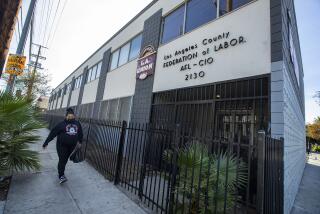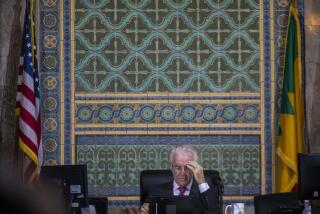L.A. City Council to shut down live video feeds of its meetings
Miriam Fogler and Donna Pearman settle into chairs at the Van Nuys Civic Center, ready to participate in a City Council meeting taking place 17 traffic-clogged miles away in downtown Los Angeles.
The room’s mostly empty, as usual, but a city safety officer is on hand to keep order. So is Michael Martin, who handles the camera equipment that will enable Fogler and Pearman to address council members.
Before going on camera, Fogler, in thick black wraparound sunglasses, gives herself a little pep talk. “We’re not part of the status quo! We’re outcasts! Gadflies!” she yells to no one in particular.
Then she realizes something is amiss. “Donna, you’re in my chair!” she bellows. Pearman moves over one seat. “This one’s where you get the best camera shot,” Fogler explains as she settles in again.
When it’s time for public comments, each walks up to the well-lit podium in the cavernous room to give her remarks via a video feed. But the pair’s usual tirades about wasteful government spending, redevelopment debacles and poor bus service give way to a seemingly unwinnable fight: staying on the air.
After Friday, the cameras go dark.
Both women understand it’s all about money.
The move to shut down the live video feeds from Van Nuys and San Pedro will save the city about $46,000 a year. The Los Angeles City Council’s line-item decision was buried among last month’s votes slashing the city’s budget in a bid to stabilize a treasury reeling from steeply lower tax revenues and higher operational costs. A city analysis shows that contractors charge $19 an hour to operate the video conferencing equipment, or just under $21,000 a year. Another $24,832 is spent to post a public safety officer part time in San Pedro (Van Nuys already has officers so there is no added expense there).
But Fogler and Pearman are having none of it.
When it’s her turn, Fogler, in a black baseball cap and a flowered muumuu, steps to the microphone.
“There is new technology now, folks, to keep this going!” she shouts, having waited nearly three hours to talk. “I’m in pain now — my tookus hurts. And now you want us to come downtown? How dare you!”
Pearman, a birdlike counterpoint to the larger-than-life Fogler, is just as dedicated to making sure the council members know she’s upset.
“It’s not just a spot for me and Miriam,” Pearman tells them, as Fogler, seated behind the podium, yells out other things for Pearman to say. “Most people don’t realize this is here. You’ve really got to think about the rights you are taking away.”
For years the two women have come to Van Nuys Civic Center to comment up to three times a week through the video-conferencing service. Along with a handful of other frequent critics, they have become, for better or worse, the public face of the San Fernando Valley, at least for anyone flipping through cable TV to watch the live council meetings on city-run Channel 35.
Fogler and Pearman are both “50-ish,” they say, and childhood friends who grew up in Van Nuys. Pearman does clerical work in a Social Security office, so she has come to the council chamber in Van Nuys only once a week. Fogler, who says she makes a few dollars collecting signatures on political petitions, has been able to attend each of the three weekly meetings.
“I want to make this city better for everyone who lives here,” Fogler said brusquely, as if that were obvious.
Pearman nods in agreement, but in a whispered aside, offers another reason for why she has been here every week.
“I have a deep crush on Eric Garcetti,” she said. Garcetti, the council’s former president, is a contender in next year’s mayoral race.
Councilman Richard Alarcon, who supports continued use of the service but was outvoted by colleagues, said cost wasn’t the only issue to doom the feed. Too few residents were taking advantage of it. In Van Nuys, for example, there are 225 rose-colored Naugahyde-padded seats.
“It’s just unfortunate that more people didn’t come to Van Nuys City Hall when they could,” said Alarcon, who represents portions of the northeast Valley. “If you come in with a strategic and specific agenda, public comments can be very effective.”
Over a one-year period ending in May, 419 speakers gave testimony at Van Nuys and 20 at San Pedro, city figures show. Mark Wolf, the city’s technology chief, said most are repeat speakers, such as Fogler and Pearman.
Wolf estimated that no more than a dozen people typically use the Van Nuys location and only a few have been constant faces. Once in while, though, a new face will wander in.
On this recent day, it is Doug Arseneault, a spokesman for the Valley Industry and Commerce Assn., a business advocacy group based in Van Nuys. Dressed in a suit and tie, he is here to comment on Item No. 6, a zoning issue on the council’s agenda.
After Friday, he’ll reluctantly drive downtown to address the council.
“We’re five minutes away from Van Nuys City Hall,” Arseneault said. “It usually takes an hour to get downtown and the parking is far more expensive.”
Fogler suspects she’s being cut off because she frequently voices support for city workers. Pearman thinks it may have more to do with a changing power structure — Councilman Herb Wesson took over as president this year.
“If Eric Garcetti was still president of the council,” Pearman said, “this wouldn’t have happened.”
Neither is sure what they will do after Friday.
For the first time that morning, Fogler goes silent. She dips her head.
“I don’t know,” she finally says. “My husband’s still working — what can I do?”
catherine.saillant@latimes.com
More to Read
Sign up for Essential California
The most important California stories and recommendations in your inbox every morning.
You may occasionally receive promotional content from the Los Angeles Times.











